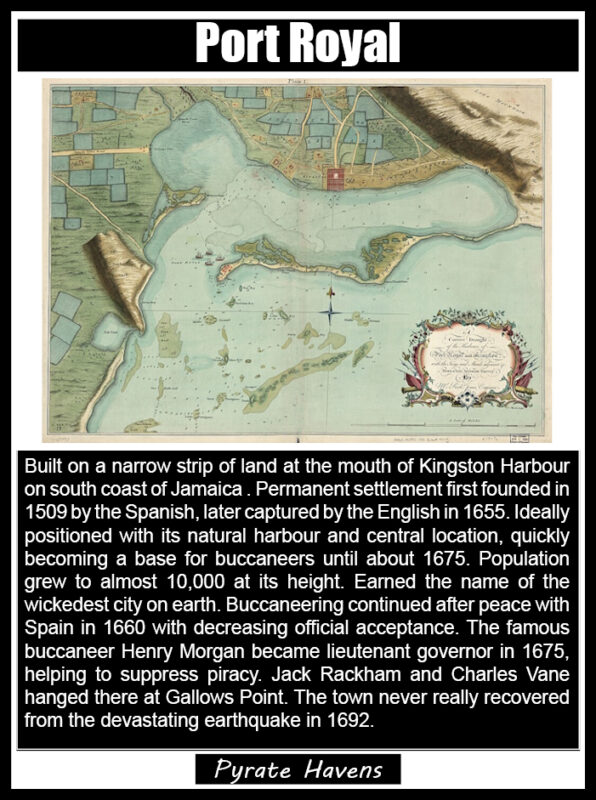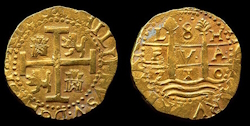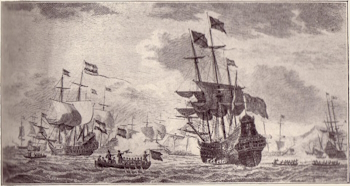
 On 31st July 1715 a Spanish treasure fleet sank during a hurricane off the east coast of Florida. It was a catastrophe for the Spanish Crown, which was heavily relying on its cargo. The galleons were fully loaded with precious cargoes of gold, silver, jewellery, tobacco, spices, indigo, cochineal etc. The Spanish government was relying its the safe arrival, as the War of Spanish Succession, which had hindered the sailing of the treasure fleets, had just come to an end. For obvious reasons, this disaster awoke the interest of pirates, privateers, and honest seamen alike.
On 31st July 1715 a Spanish treasure fleet sank during a hurricane off the east coast of Florida. It was a catastrophe for the Spanish Crown, which was heavily relying on its cargo. The galleons were fully loaded with precious cargoes of gold, silver, jewellery, tobacco, spices, indigo, cochineal etc. The Spanish government was relying its the safe arrival, as the War of Spanish Succession, which had hindered the sailing of the treasure fleets, had just come to an end. For obvious reasons, this disaster awoke the interest of pirates, privateers, and honest seamen alike.
The Spanish treasure fleets
 Treasure fleets consisting of a dozen or more ships used to sail from Cádiz or Seville in Spain, bringing European goods not readily available in the New World to the colonies with the aim of returning with gold, silver and other goods from Peru and Colombia, as well as spices and other items from south east Asia, brought across the Pacific by the Manila Galleon, which was then transported by mule train across the isthmus of Panama.…
Treasure fleets consisting of a dozen or more ships used to sail from Cádiz or Seville in Spain, bringing European goods not readily available in the New World to the colonies with the aim of returning with gold, silver and other goods from Peru and Colombia, as well as spices and other items from south east Asia, brought across the Pacific by the Manila Galleon, which was then transported by mule train across the isthmus of Panama.…
This proclamation was published in The Boston Gazette on October 17, 1720, along with a proclamation for the apprehension of the named pirates issued by Governor Rogers.
New Providence, 4th September
Several pirates are on the coast of the Bahamas, among which is one Rackam who ran away with asloop of six guns and took with him twelve men and two women. The governor of this place sent a sloop with 45 men after him. And on the second instant Doctor Rowan with his sloop and 54 hands, twelve guns, went out in order to suppress them, as did Captain Roach who arrived here from Barbados. The pirates swear destruction to all those who belong to this island.
BY HIS EXCELLENCY
WOODES ROGERS, ESQ.
GOVERNOR OF NEW PROVIDENCE, &C,
A PROCLAMATION
Whereas John Rackam, George Featherstone, John Davis, Andrew Gibson, John Howell, Noah Patrick and two women, by name Anne Fulford alias Bonny and Mary Read, did on the 22nd of August last combine together to enter on board, take, steal, and run away with out of this road of Providence, a certain sloop called the William, burthen about twelve tons, mounted with four great guns and a swivel one, belonging to Captain John Ham, and with the said sloop did proceed to commit robbery and piracy upon the boat and effects of James Gohier, Esq.,…
The Proclamation for Suppressing of Pirates was also known simply as the Act of Grace, although not actually an Act of Parliament). It was a royal proclamation issued by George I of Great Britain on 5th September 1717.
It promised a pardon for any acts of piracy committed before the following 5th January 1718 to those pirates who surrendered themselves to the authorities before a deadline of 5th September 1718, was subsequently extended to 1st July 1719 by a second proclamation in December 1718. The proclamation also included bounties for the capture of pirates who refused to surrender themselves.
You can read the original text from The London Gazette of 13th September 1717 from The Gazette website, or download it in PDF format by clicking on the image: